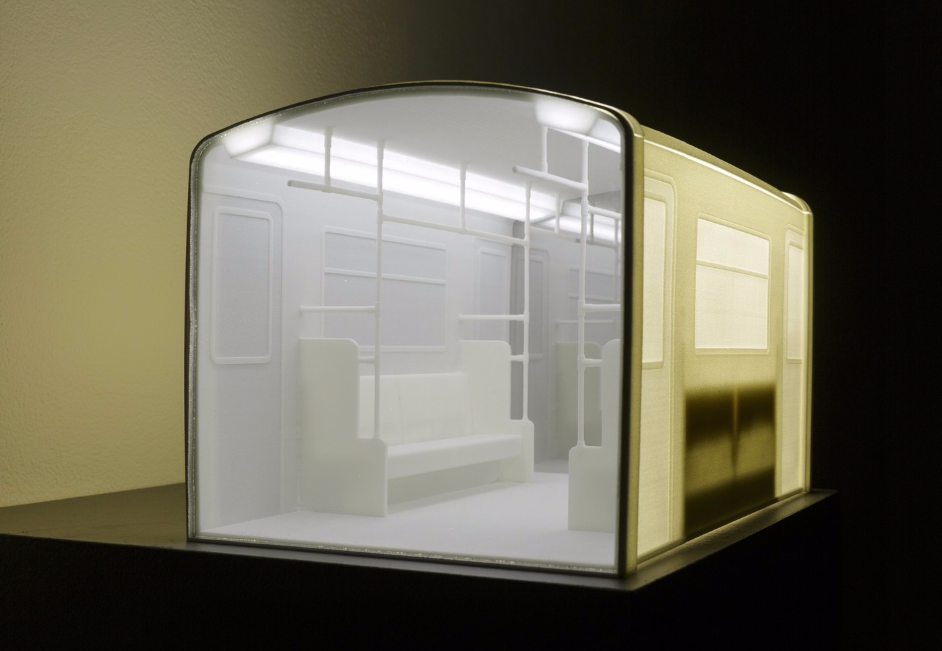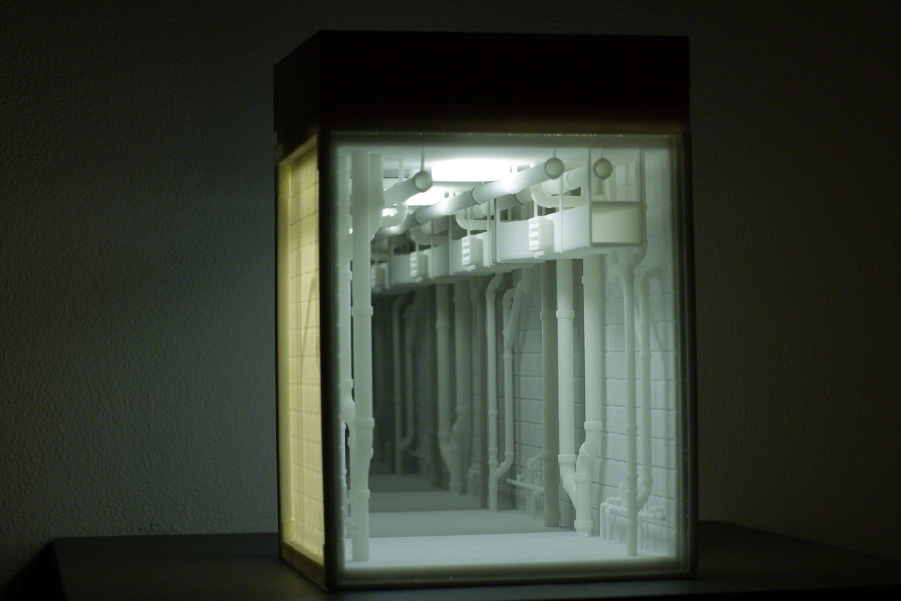There’s something so compelling and, conversely, off-putting and potentially even anxiety-provoking about the 3D printed dioramas of Montréal-based artist Guillaume Lachapelle. This sculptor–who is clearly inspired by architecture and the human impulse to organize and standardize space, particularly communal space–creates meticulous models reminiscent of the miniature stage sets produced in intricate detail. Lachapelle’s sets, however, are sterile versions of those often elaborate maquettes. Rather than suggesting that, in the context of one of the small-scale worlds that action will erupt momentarily, the Québec artist’s sets are devoid of human presence, monochromatic and in a sense scrubbed clean of life.
The models, some of which are no larger than about 6″ x 6” x 12”, largely represent interior spaces arranged in grid-like fashion. Relying on feints of mathematical perspective, including utilizing mirrors in many instances, the sculptor creates the illusion of diminution into seemingly infinite space, most ironically within the confines of the small diorama.
One piece, titled Nuit étoilée (Starry Night, 2012), of the three representing exterior spaces, recreates an ubiquitous parking lot lit by four-armed streetlights, the poles of the lamps and the lines painted onto the tarmac stretch out and diminish into the distance as though the lot is endless. Another piece, Rêve collectif (Collective Dream, 2014), again relies on an orderly grid and diminution to invoke the homogeneity of suburban life as expressed in the seemingly limitlessness of a landscape filled with identical houses.
Lachapelle turned to the banality of interiors like train cars and office spaces with Metro (2013) and Vie secrète (Secret Life, 2014), respectively. With mirrors and, with the ease of reproducing veristic details that 3D design facilitates, the sculptor again creates the illusion of endlessness and even tedium at the same time that the virtuosity of these works in their protective cases lends an air of magic to the mundane, whether the factory-produced seats and poles of the subway car or the pipes and duct work of an other, subterranean world actually do hint at secrets perhaps never to be revealed.
In a 2010 interview with Montréal newspaper La Presse, Lachapelle explained that, prior to the advent of 3D printing, he used traditional methods and materials for creating and manufacturing his sculptures. Now, he creates the models (presumably after producing a series of conventional, 2D sketches) using SketchUp and then 3D prints them in nylon and other materials (although nylon seems to be a favored medium).
This past summer, Lachapelle exhibited his work at Art Mûr, a Montréal gallery. The show, which he titled Visions, presented a sort of retrospective of his oeuvre with older works produced using more traditional techniques and more recent ones that were largely produced via 3D printing. Notably, it is difficult to discern which works originate from his pre-3D printing period and which do not.
This indistinguishability is certainly, among other things, a testament to the capacity of 3D printing not to usurp or render obsolete traditional methods of artistic production but, rather, to augment them and, in the case of Lachapelle’s work, to facilitate the kind of uncanny verisimilitude that makes his work so compelling and unsettling at once.
Discuss these incredible creations in the 3D Printed Dioramas forum thread over at 3DPB.com.
Subscribe to Our Email Newsletter
Stay up-to-date on all the latest news from the 3D printing industry and receive information and offers from third party vendors.
You May Also Like
3D Printing Webinar and Event Roundup: May 5, 2024
We’ve got a busy week of 3D printing events ahead of us, in Texas, Florida, Washington, D.C., Shanghai, and more. Webinar offerings will cover medical models, PolyJet 3D printing, additive...
High Stakes, High Speed: KVG Acquires 15 Nexa3D HSE 3D Printers to Boost Military Tech
As 3D printing increasingly intersects with defense and military logistics, a new partnership between Nexa3D and mission support logistics firm KVG stresses the growing importance of this technology in strategic...
Construction 3D Printing CEO Reflects on Being Female in Construction
Natalie Wadley, CEO of ChangeMaker3D, could hear the words of her daughter sitting next to her resounding in her head. “Mum, MUM, you’ve won!” Wadley had just won the prestigious...
3D Printing News Briefs, February 17, 2024: Shot Blasting, Service Bureaus, & More
In today’s 3D Printing News Briefs, we’re starting out with post-processing, as SKZ Würzburg is using a shot blast system from AM Solutions for its research. Moving on to business,...


































